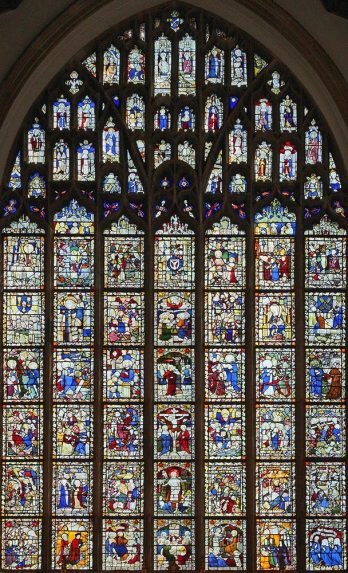Church of St Peter Mancroft, Norwich
Address
Church of St Peter Mancroft, Hay Hill, Norwich NR2 1QQRecommended by
Highlight
East windowArtist, maker and date
15th century school of Norwich glass paintersReason for highlighting
The beautiful church of St Peter Mancroft contains what is generally accepted as the finest stained glass in Norfolk. The bulk of the church’s surviving medieval glass is now located in the east window where forty two panels are all of medieval date. Although many have been “patched” they are remarkably intact. It is especially interesting to “spot” the Victorian replacement panels which despite the huge technological advances of the intervening years do not match the delicacy of touch and design achieved by the medieval craftsman.
Interestingly none of the glass is in situ having being moved on a number of occasions including : John Dixon’s “improvements” dating from 1847–51; Clayton and Bell’s work of 1881; and G King and Son’s 1947 reinstallation of the window following its removal over the War years, which included the releading and rearrangement of the tracery lights.
Artist/maker notes
Clayton & Bell is one of the best known and most prolific studios of the Victorian Age. The original partners, John Richard Clayton (1827-1913) and Alfred Bell (1832-95), were encouraged into business by Sir George Gilbert Scott, who would go on to use the firm for numerous commissions, as did G E Street and J L Pearson.
While the output of the firm would become prodigious, it also affected the development of stained glass through the significant number of artists, who spent time with the firm, including Charles Eamer Kempe, John Burlison and Thomas Grylls, and Robert Bayne.
Source: Angels & Icons: Pre-Raphaelite Stained Glass 1850-1870 by William Waters (Seraphim Press Ltd 2012)
John Dixon (1783-1857) was a churchwarden at St Peter Mancroft, Norwich, plumber-glazier, and former manufacturer of water closets. He removed seven medieval panels from the east window to make way for his own figure of St Peter. Some of the discarded medieval originals were acquired by William Howe Windham (1802–1854) of nearby Felbrigg Hall, where they were installed by Dixon alongside panels of his own manufacture (King, Medieval Stained Glass, pp. lxvii–lxviii, 172–75).
Source: Quoted in Brown S., (2020) “Medieval Stained Glass and the Victorian Restorer”, 19: Interdisciplinary Studies in the Long Nineteenth Century 2020(30). https://doi.org/10.16995/ntn.2901
G. King & Son Ltd, Lead Glaziers of Norwich, like many glazing firms, was a family affair, handed down from father to son through three generations. Founded in 1927, it became a by-word for quality in stained glass restoration, conservation and the understanding of the medium. The workshop finally closed in 2003, with the retirement of Michael King.



Other comments
Examples of the work of John Dixon, Clayton & Bell, and G King & Son (to a 1968 design by Andrew Anderson) can be found elsewhere in the church, along with a large and attractive south aisle east window by Hebert Hendrie, c. 1921.
Further reading:
Norfolk Stained Glass – St Peter Mancroft
The Medieval Stained Glass of St Peter Mancroft, Norwich by David King (CVMA (GB), V, Oxford, 2006)
Stories in Glass – A Guide to Medieval Stained Glass in Norfolk by David King (The Lutterworth Press, 2024)